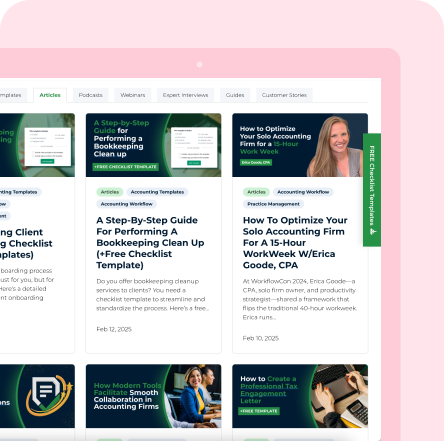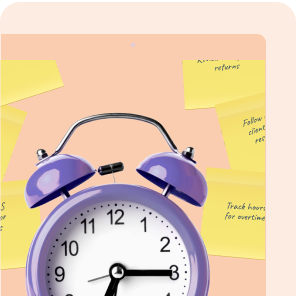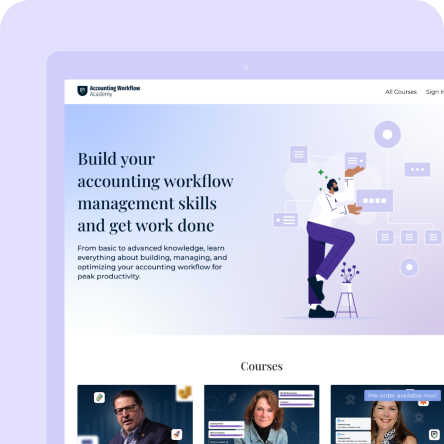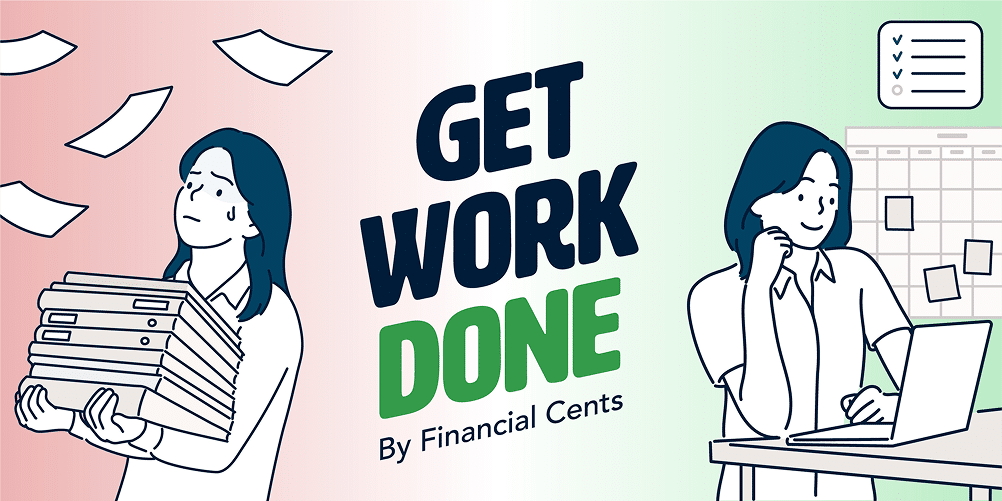S01 E17: How this firm owner converted her brick & mortar firm to the cloud
Guest: Agnes Nkundabagenzi
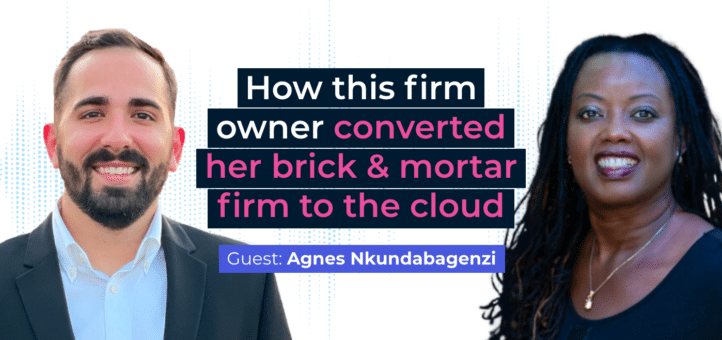
Podcasts » S01 E17: How this firm owner converted her brick & mortar firm to the cloud
Meet Agnes Nkundabagenzi, the founder of Controller4Hire, a cloud-based bookkeeping firm. The firm is made up of 7 team members and they service over 225 clients.
In this episode, we talk about how she made the manual switch to taking her firm virtual.
Timestamps:
Introduction 0:01
The adoption process for virtualization. 4:03
How to train your team on new solutions. 5:24
Getting clients to adopt new technology. 9:28
How did you convert your clients to the package model? 11:28
Advice for people thinking about moving to the cloud. 15:05
How to choose a workflow app for accounting firms? 17:17
Advice on starting your own firm. 20:28
Shahram Zarshenas: Hey everyone, welcome to the Accounting Firm Podcast. Are you struggling to grow your accounting firm? Not anymore. This is where you get actionable insights every week into how to scale your firm. Each week, we will spend 15 minutes interviewing actual accounting firm owners just like you, so you can learn how they overcame the biggest challenges that you will face when growing your firm. Let’s get started. Hey everybody. Today we’re talking to Agnes about how she converted her firm from brick-and-mortar to the cloud. Agnes is the owner of Controller for Hire. She manages a team of seven people and currently serves over 225 clients. Agnes, it’s great to have you on the show today!
Agnes: Thanks for having me. I’m excited to be here.
Shahram Zarshenas: Yeah, definitely. This is an exciting topic. A lot of firms, ever since COVID, have been moving from brick-and-mortar to the cloud, not just because they were forced to go remote, but because there are a lot of benefits to it. So, I think a lot of people are going to get great insights from this. Before we jump in, tell us a little bit about your firm. Who you are, what you do, and what you’re all about.
Agnes: So, we are a small cloud-based firm. We have about 225 clients, and we provide cloud-based bookkeeping, income tax and corporate tax return services, and fractional CFO services. We are based in Vancouver, BC, and we serve clients all over Canada. Our goal is to leverage technology to provide efficient and reliable accounting services to our clients, no matter where they are located.
Shahram Zarshenas: Okay, perfect. Thanks for that introduction. So, to start off, let’s talk about why you wanted to convert the firm to the cloud. And just to give some context, you acquired the firm, correct?
Agnes: Yes, I acquired a client list from an accountant who was retiring. He was using Sage and the old model where you have a server, and clients drop off their paperwork every month. When I met with him, I realized that there was an opportunity to use technology to convert the firm to the cloud. The traditional method involved a lot of manual processes and physical paperwork, which I knew could be streamlined with cloud-based solutions.
Shahram Zarshenas: So you saw the opportunity. What benefits did you see that could be obtained by doing this?
Agnes: The technology offers a lot of efficiencies, such as eliminating manual entry. I live in Vancouver, and the firm was in Victoria, which is a couple of hours away. By bringing all the clients to the cloud, I could service them without having to move to Victoria, which was important because my family is here in Vancouver. Additionally, cloud-based systems offer real-time access to financial data, enhanced security, and the flexibility to work from anywhere. This not only improves our service delivery but also allows us to scale more effectively.
Shahram Zarshenas: How has that transition gone so far? When did you acquire the firm, and how long have you been making this transition? Are you complete yet?
Agnes: Yes, we’ve completed the transition. We maintained the office for the last four years and just closed it down. It went really well, partly due to COVID, which pushed people to adopt digital solutions. The pandemic accelerated the need for remote work solutions, making it easier for us to implement the changes. Clients were more receptive to the idea of virtual meetings and electronic document transfers because in-person interactions were limited.
Shahram Zarshenas: Let’s talk about that process. One of the biggest challenges with going to the cloud or taking your firm virtual is getting adoption by the team, right? What was that like? Did your team push back on adopting these new technologies? How did you overcome those challenges?
Agnes: There were two main challenges: getting clients to adopt the cloud and getting the team to adopt it. COVID helped a lot with clients, as they had to do everything over the cloud. Internally, the team was used to the old way of doing things. Training and getting the team to come on board was the most challenging part. We had to invest in a lot of training sessions and provide continuous support to ensure everyone was comfortable with the new tools and processes. Resistance to change is natural, especially when people are used to a certain way of working for many years.
Shahram Zarshenas: Is there anything that you did to make it easier for your team? Any specific process you put in place for training them on the new solutions?
Agnes: We decided to convert 10 clients at a time to QuickBooks and had help from a dedicated QuickBooks team. The bookkeepers needed to learn how to use QuickBooks Online, which was different from Sage. If I had known better, I would have provided more training and support because QuickBooks, while intuitive, still posed a challenge for those not used to technology. We also implemented a phased approach to roll out new tools, starting with the most critical ones and gradually introducing others. Regular check-ins and feedback sessions were crucial to address any issues promptly.
Shahram Zarshenas: Did you have any attrition on your team during this conversion process? Did you lose any team members and have to fill new roles?
Agnes: Yes, I ended up losing a few team members and hired new ones who were more suitable and bought into my vision. I wish I had realized sooner that some people are just not meant for this transition and that it’s better to react quickly. It was a tough decision, but necessary to ensure the firm’s success. Bringing in new team members who were enthusiastic about the changes made a significant difference. They brought fresh perspectives and were more adaptable to the new technologies.
Shahram Zarshenas: That’s a common narrative. It’s rare to talk to someone who’s made this conversion without losing a few team members. For those listening and considering converting their firm, it’s important to be prepared for that.
Agnes: Yes, be prepared to pivot quickly and hire people who buy into your vision. Adopting new communication technologies was also challenging for some team members. It was a lot of change in a short period, especially for someone who had been with the firm for years. However, once they saw the benefits and got used to the new systems, they appreciated the efficiencies and improved workflows.
Shahram Zarshenas: Let’s talk about some of the tools you implemented. What does your virtual firm tech stack look like today?
Agnes: We use Financial Cents for workflow management, Google Drive for document storage and management, Sync for secure document sharing, Slack and Zoom, and Google Meet for communication. Each of these tools plays a crucial role in our operations. Financial Cents helps us track tasks and deadlines, ensuring nothing falls through the cracks. Google Drive allows us to store and organize documents efficiently, while Sync provides a secure way to share sensitive information with clients. Slack and Zoom facilitate real-time communication and virtual meetings, keeping everyone connected and on the same page.
Shahram Zarshenas: Are there any solutions you’re planning on adding to that tech stack?
Agnes: I’ve been considering adding Miro for presentations and team collaboration. It’s been working well when we need to outline tasks and responsibilities. Miro is an interactive whiteboard platform that allows us to brainstorm and collaborate visually. It’s especially useful for team meetings and project planning, providing a more engaging way to discuss ideas and track progress.
Shahram Zarshenas: How did you convert your clients to interacting with your firm virtually? Was it easy for them to get comfortable with the new process?
Agnes: COVID made it easier as it forced everyone to adopt digital communication. It took time at the beginning to earn clients’ trust and introduce changes gradually. Once I earned their trust, it became easier to get them to adopt new methods. We held virtual onboarding sessions to walk clients through the new processes and tools, ensuring they felt supported and confident in using them. Additionally, we provided detailed guides and tutorials to help them navigate the new systems independently.
Shahram Zarshenas: Did you change your pricing model or any other aspects of the client relationship?
Agnes: Yes, we moved to a package model from an hourly rate. This took time and involved showing clients the added value of a fixed fee that included more interactions with senior accountants and other services. Clients appreciated the predictability and transparency of the package model. It also allowed us to offer more comprehensive services and build stronger, long-term relationships with our clients. By bundling services, we could provide better value and ensure clients received the support they needed without worrying about fluctuating costs.
Shahram Zarshenas: Did this pricing change result in an increase in revenue for your firm?
Agnes: Yes, it provided more consistent cash flow and made it easier to upsell additional services like fractional CFO services. The package model also helped us streamline our billing processes, reducing administrative overhead and improving cash flow management. Clients valued the simplicity and clarity of the fixed fees, which made it easier for them to budget and plan their finances.
Shahram Zarshenas: It sounds like you’ve had a lot of success with taking your firm virtual. Before we move into the quickfire questions, if you were looking back at this process, what is one piece of advice you’d give to someone considering going virtual?
Agnes: Take the time to share your vision with your team and get them to buy into it. You can’t do this alone. Also, be strategic about the technology you choose, as there’s a lot of learning involved. It’s important to ensure that
It’s important to ensure that the technology you choose aligns with your firm’s needs and goals. Don’t rush into adopting new tools without thoroughly evaluating them. Test different solutions, get feedback from your team, and make sure everyone is comfortable with the new systems. It’s also crucial to plan for a learning curve. Provide ongoing training and support to help your team and clients adjust to the changes. Remember, the transition to a virtual firm is a journey, not a sprint.
Shahram Zarshenas: Yeah, there are a lot of apps out there. Make a list of deal breakers and use your community to narrow down the options. Let’s move on to quickfire questions. If you could go back in time when starting your firm, what’s one piece of advice you’d give yourself?
Agnes: I should have started with cloud accounting earlier. Embracing technology from the start would have positioned us better for growth and efficiency. It’s easy to get comfortable with traditional methods, but the earlier you adapt to modern solutions, the better it is for the long-term success of your firm.
Shahram Zarshenas: What trait do you think is important to be a successful firm owner?
Agnes: Believe in what you’re doing, be fearless, and stay updated with new products and ways of doing things. The accounting industry is constantly evolving, and it’s important to stay ahead of the curve. Be open to change, continuously seek out new knowledge, and don’t be afraid to take risks. Having confidence in your vision and the value you bring to clients is crucial.
Shahram Zarshenas: What is a software tool you can’t live without to run your firm?
Agnes: QuickBooks and a good workflow system are indispensable. QuickBooks handles all our accounting needs, and our workflow system keeps everything organized and on track. These tools are the backbone of our operations, ensuring we deliver consistent and high-quality service to our clients.
Shahram Zarshenas: What’s your favorite accounting resource?
Agnes: I rely on various blogs and a group of accountants I meet with regularly. It’s not just about the content, but the community and support that comes with it. We exchange ideas, discuss challenges, and share solutions. It’s invaluable to have a network of peers who understand the unique aspects of our industry. Some of my go-to blogs include ones that focus on the latest industry trends, technological advancements, and best practices in accounting.
Shahram Zarshenas: Lastly, how many hours a week do you typically work?
Agnes: Around 30 hours on average, but it can go up to 50 during tax season. Balancing work and personal life is important, so I try to maintain a manageable workload. The flexibility of a cloud-based firm allows me to work efficiently and still have time for my family. During peak seasons, I plan my schedule meticulously to ensure I can meet all client needs without compromising on quality.
Shahram Zarshenas: Thank you so much for coming on the show, Agnes. Anything else you’d like to leave with the guests?
Agnes: Just to reiterate, the transition to a virtual firm is a significant but rewarding journey. Take the time to plan, communicate your vision, and support your team through the changes. Embrace the technology, and be patient with the process. The benefits far outweigh the challenges. Thank you for having me.
Shahram Zarshenas: Thanks everyone for listening. If you enjoyed this podcast, please write a review to help other firms find our podcast and gain insights into how to grow their firm. See you next week.
